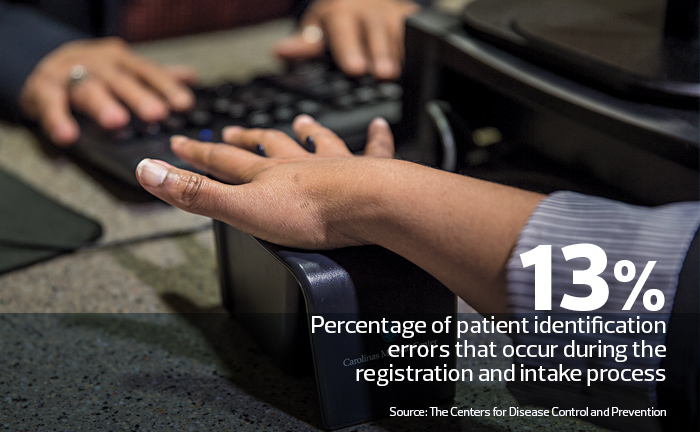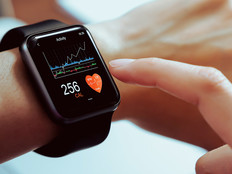Palm Readers, Creative Solutions Make Patient Identification Personal
Officials at Carolinas HealthCare System have zero tolerance for errors caused by duplicate patient records.
For the Charlotte, N.C.-based system, which runs 39 hospitals and more than 900 care sites throughout North and South Carolina, each error represents a patient safety concern that could have been avoided, says Mike Hill, assistant vice president for information and analytics services.
Fueled by such concerns, Hill and Carolinas HealthCare System became an early adopter of Imprivata PatientSecure, which allows healthcare organizations to accurately associate each patient with his or her record using a unique palm-vein biometric. The technology has helped the provider to dramatically decrease duplicate record errors, now down to 0.1 percent.
“We really wanted to ensure that each patient had just one unique record in our electronic health record system,” Hill says.
Carolinas HealthCare System is not alone in prioritizing technology’s role to combat patient identification errors. Providers like the University of Utah Health Care, and organizations like the ECRI Institute and the College of Healthcare Information Management Executives (CHIME), also believe technology is critical to help address an issue that continues to plague the industry.
Health IT Partnerships Help Put Safety First
As the healthcare industry continues to embrace IT to help manage more patients, share critical information and improve outcomes, the chances of an identification error grows dramatically, says Dr. Hardeep Singh, chief of the health policy, quality and informatics program at the Houston Veterans Affairs Health Services Research Center of Innovation.
 “A lot of hospitals and healthcare organizations are missing the big picture here because they’re not looking at and measuring how common and bad the problem has gotten,” says Singh, who also serves as chairman of the Partnership for Health IT Patient Safety, an ECRI Institute collaborative. ECRI ranks patient identification sixth on its “Top 10 Patient Safety Concerns for Healthcare Organizations” 2017 list.
“A lot of hospitals and healthcare organizations are missing the big picture here because they’re not looking at and measuring how common and bad the problem has gotten,” says Singh, who also serves as chairman of the Partnership for Health IT Patient Safety, an ECRI Institute collaborative. ECRI ranks patient identification sixth on its “Top 10 Patient Safety Concerns for Healthcare Organizations” 2017 list.
Pulling the wrong record, for example, can lead to a patient undergoing an unneeded procedure or receiving medication that causes an adverse reaction, Singh says. A 2016 analysis of the issue by ECRI found that several patients significantly suffered or died due to care providers working from the wrong patient record.
A major reason why the issue is so difficult to solve is that patient misidentification and related medical errors can occur at any point in the healthcare process, from registration to the operating room to outpatient rehab or nursing home care. And it’s not just a technology issue, Singh says. Lack of standardization exists throughout the patient identification process, often within the same healthcare organization, he says. Human error represents another major culprit.
“People don’t use identifiers correctly,” Singh says. “They get distracted while entering information, they don’t label specimens correctly — there are just so many things that can, and do, go wrong.”
Saving Time and Streamlining Identification
At University of Utah Health Care, the Salt Lake City-based organization had already taken manual back-end steps to get its duplicate record rate down to just 1 percent, but executives sought greater progress. To get as close to perfect as possible, last winter, the four-hospital, 12-clinic organization also rolled out Imprivata’s biometric-based patient identification scanner technology at all registration points.
The scanner works as such: A near-infrared light initially records a patient’s vein pattern. From there, a unique biometric template is developed, which is linked directly to the patient’s electronic health record (EHR).
Returning patients then register by scanning their palm and providing their birthdate at check-in. The technology has reduced check-in time to about 10 seconds per patient, says Nancy Brazelton, director of application support and change management.
Moreover, it’s eliminated the potential that a registrar will inadvertently select the wrong patient from a list of names presented on their screen and reduces the likelihood of medical identity fraud. It also enables caregivers in the emergency room to quickly and accurately identify nonresponsive stroke or trauma patients.
“All of this really goes back to patient safety,” Brazelton says. “We want to match the correct patient to their correct record in our EHR 100 percent of the time.”
Pushing Use By Getting to the Point
Like the University of Utah, the scanners at Carolinas HealthCare System integrate easily with the organization’s registration systems for the hospitals and ambulatory care settings. Each scan uses an algorithm to encrypt and then securely store a representation of the palm-vein pattern within the organization’s master patient index.
To encourage patients to use the scanners, the Carolinas HealthCare System implementation team developed a script for frontline registrars that explains the technology’s benefits while also addressing potential concerns.
“We found that if we craft that message carefully, then most patients will immediately enroll in the program,” Hill says. “Once they enroll, it becomes an expectation that they can palm-scan at any of our locations.”
The result? More than 96 percent of patients now participate in the biometric program, even as its patient population has skyrocketed.
Contests Encourage Better Patient ID Tech
Patient identification is such a challenge for healthcare CIOs that in 2016, CHIME launched the $1 million National Patient ID Challenge. The goal: accelerate the creation and adoption of a solution to ensure 100 percent patient identification in the United States, says Russell Branzell, president and CEO.
“The very essence of knowing who a patient is represents the cornerstone of patient safety and care,” he says.
The challenge initially drew 371 innovators from 38 countries. Entrants were required to demonstrate how their proposed solutions could accurately enroll and identify patients within 44 use cases (such as those presenting with injuries to the face, eyes and limbs) or individuals trying to enroll with fraudulent identification.
Participants also provided specifics on the scalability and adoptability of their solutions, as well as how they accounted for fraud and security. CHIME will announce a winner from seven finalists in November.
“Reading through the submissions, there’s great hope,” Branzell says. “I’m very optimistic that there are technologies and solutions that can be cast into a framework to help solve this problem at a macro level."







